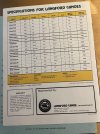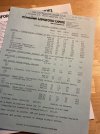Lastkozak
The season ends, when I can't break thru the ice!
Hi,
I just obtained what appears to be a 15' Langford Canoe; for free. The decal is similar to the photo posted on this site by someone else, right down to how it has worn and torn! Except it is yellow and black.
My Langford is in really good shape, just needs new canvas and a new keel. I cannot find a serial number however, but it looks like a rib has been replaced at some point. It also seems to show signs of at least one re-canvas job carried out.
Other anomalies I have noticed are; steel Roberts screws holding the outer Gunwales on! Rusted and a pain to remove. Also steel nails holding the top hull plank/board on, underneath the Gunwales. I have also found the bolts used to fasten the seat and Yoke made of steel. The greatest perplexing aspect of it is steel nails in the bow and stern, all the way below the water line; also rusted.
I thought all this was a no no! I have thought up several scenarios as to why steel was used, but would love to hear from some experienced canoe people their thoughts or knowledge on such a material being used. Since there is no serial number I am hoping any knowledge as to why steel was used could give me a better idea of its date.
Of course the rest of the canoe has copper nails, but no brass nails, and I cannot tell if any of the copper nails are actually bronze.
I am not even sure if I should bother refurbishing it properly, or just get it floating, painted and water proofed.
I just obtained what appears to be a 15' Langford Canoe; for free. The decal is similar to the photo posted on this site by someone else, right down to how it has worn and torn! Except it is yellow and black.
My Langford is in really good shape, just needs new canvas and a new keel. I cannot find a serial number however, but it looks like a rib has been replaced at some point. It also seems to show signs of at least one re-canvas job carried out.
Other anomalies I have noticed are; steel Roberts screws holding the outer Gunwales on! Rusted and a pain to remove. Also steel nails holding the top hull plank/board on, underneath the Gunwales. I have also found the bolts used to fasten the seat and Yoke made of steel. The greatest perplexing aspect of it is steel nails in the bow and stern, all the way below the water line; also rusted.
I thought all this was a no no! I have thought up several scenarios as to why steel was used, but would love to hear from some experienced canoe people their thoughts or knowledge on such a material being used. Since there is no serial number I am hoping any knowledge as to why steel was used could give me a better idea of its date.
Of course the rest of the canoe has copper nails, but no brass nails, and I cannot tell if any of the copper nails are actually bronze.
I am not even sure if I should bother refurbishing it properly, or just get it floating, painted and water proofed.






